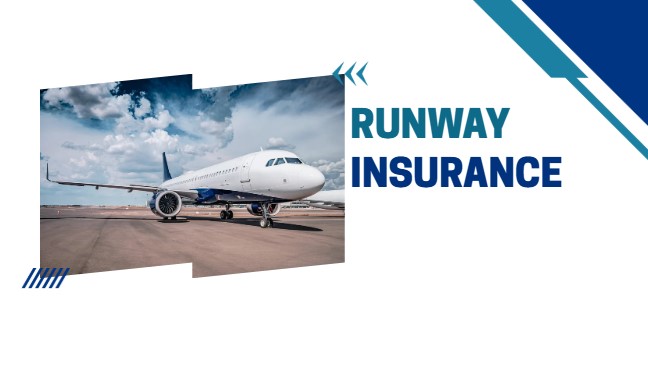What Is Runway Insurance?
Runway insurance refers to a specialised type of property and liability coverage designed to protect against incidents and damages occurring on or near airport runways. These policies typically cover physical damage to runways, collisions, foreign object damage (FOD), weather-related harm, and third-party liability claims.
Whether it’s a minor surface crack or a full-scale runway incursion, the costs can be staggering. Repair bills, grounded flights, regulatory fines, and lawsuits are all potential financial burdens that runway insurance can mitigate.
Why Runway Risks Can’t Be Ignored
Aviation is synonymous with precision, and that doesn’t end when an aircraft touches the ground. Runway Insurance s and taxiways are critical components of aviation safety and infrastructure, but they’re also exposed to risks — from aircraft overshooting runways to ground vehicle collisions and foreign object debris (FOD) damage.
These incidents can result in lawsuits, cleanup costs, repair bills, and operational shutdowns. Traditional liability insurance may not provide specific coverage for these risks. Runway insurance fills that gap, giving operators a safety net they can depend on.
Also read: GoAuto Insurance
Core Components of Runway Insurance
1. Property Damage Coverage
This includes physical damage to the runway, lighting systems, navigational aids, and surrounding structures. It can also cover repair costs for cracks, fire damage, or FOD-related surface deterioration.
2. Third-Party Liability
If an incident on a runway causes harm to third parties — such as passengers, crew, or ground personnel — liability coverage Runway Insurance protects the insured from associated legal and medical costs.
3. Environmental Cleanup
Runway incidents, especially involving fuel spills or hazardous material leaks, may trigger environmental liability. This Runway Insurance coverage helps handle cleanup, disposal, and potential regulatory fines.
4. Business Interruption
Unexpected closure of Runway Insurance due to damage or accident can halt airport operations. Some policies may offer limited reimbursement for lost revenue or extra operational costs during the shutdown.
5. Runway Incursion Events
Covers liability from unauthorised or accidental entries onto active runways by aircraft, vehicles, or personnel that may result in near-miss events or collisions.
Who Needs Runway Insurance?
Runway insurance is not limited to large international airports. Various entities benefit from this protection:
- Public Airports: With heavy traffic and public accountability, municipalities need comprehensive risk transfer mechanisms.
- Private Airfields: Even with fewer flights, private operators face similar hazards without public funding safety nets.
- Aviation Businesses: Charter operators, FBOs, and MRO facilities often interact with runway spaces.
- Flight Schools: With frequent Runway Insurance takeoffs and landings, the likelihood of minor incidents increases.
- Drone and UAV Testing Sites: As unmanned aircraft become more common, so do new runway-related risks.
Why Runway Insurance Matters in today’s Aviation Ecosystem
Aviation safety has always been a top priority, but as traffic volumes grow and regulations tighten, ground operations are receiving more scrutiny. Here’s why runway insurance is becoming increasingly essential:
Regulatory Pressures: Aviation authorities are increasing accountability for preventable runway incidents.
Ageing Infrastructure: Older runways are more prone to damage, increasing the likelihood of claims.
Climate Change: Extreme weather conditions increase the risk of runway damage and disruption.
Higher Costs: Runway repair, aircraft damage, and legal settlements are increasingly expensive.
Without proper coverage, even Runway Insurance one serious incident can financially strain or bankrupt an airfield or aviation service provider.
Structure & Policy Options in Runway Insurance
A. Standalone vs. Event Insurance
Standalone policies are flexible and designed for single shows.
Annual or blanket policies cover a season’s worth Runway Insurance of runway events.
B. Required Endorsements
Additional coverage Riders may be needed for specific exposures—e.g., high-value gowns, drone cameras, or overseas shoots.
C. Geographic Coverage
Required for international shows—regions/domestic vs international coverage
D. Aggregate vs. Per-Occurrence Limits
Aggregate caps total annual payout
Per-occurrence limits restrict single-incident payouts
E. Deductibles & Premiums
Higher deductibles Runway Insurance lower premiums (e.g., US $1,000–5,000)
Premium varies with show size, venue, and model risk exposure
Calculating Insurance Cost
Premiums are influenced by:
Event scale and attendance
Venue type (outdoor vs. indoor)
Model physical risk
Wardrobe value
Claim history
Rough premium ranges:
Small brand/event: $1,500–3,500
Runway Insurance major runway (NY, Paris): $5,000–15,000+
Large fashion houses: $20,000+ for full-season coverage
Real-World Example: A Costly Overshoot
In 2022, a mid-sized regional airport faced a runway overshoot involving a private jet. The incident damaged both the lighting system and perimeter fencing. Runway Insurance cleanup involved fuel remediation and environmental monitoring. Though no injuries occurred, the financial damage exceeded $650,000. Thanks to runway insurance built into the airport’s liability policy, over 90% of the costs were covered, and operations resumed within three days.
Why Every Airport Should Prioritise Coverage
Ignoring runway risks can lead to catastrophic financial consequences. Not only does insurance offer peace of mind, but it also ensures operational resilience during disruptions. As Runway Insurance aviation continues evolving, insurance will be central to protecting the very surface that keeps air travel moving.
Stakeholders in the aviation ecosystem should treat runway insurance not as a secondary option but as a frontline defence. Runways are foundational assets, and protecting them is both a strategic and financial imperative.
Final Thoughts
Whether you’re managing a small airfield or a sprawling international airport, runway insurance is an essential tool in your asset protection toolkit. From environmental threats to operational hazards, it provides comprehensive support when things go wrong.
If you’re unsure about your current risk exposure or think it’s time to revisit your existing policy, connect with a trusted aviation insurance provider. Protect your runway—and Runway Insurance your reputation—with the right policy in place.

